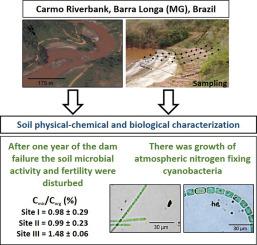当前位置:
X-MOL 学术
›
Appl. Soil Ecol.
›
论文详情
Our official English website, www.x-mol.net, welcomes your feedback! (Note: you will need to create a separate account there.)
Physical, chemical and microbiological characterization of the soils contaminated by iron ore tailing mud after Fundão Dam disaster in Brazil
Applied Soil Ecology ( IF 4.8 ) Pub Date : 2021-02-01 , DOI: 10.1016/j.apsoil.2020.103811 Fernanda Resende Couto , Angela de Mello Ferreira , Patrícia Procópio Pontes , Andréa Rodrigues Marques
Applied Soil Ecology ( IF 4.8 ) Pub Date : 2021-02-01 , DOI: 10.1016/j.apsoil.2020.103811 Fernanda Resende Couto , Angela de Mello Ferreira , Patrícia Procópio Pontes , Andréa Rodrigues Marques

|
Abstract The collapse of the Fundao dam in Mariana – Minas Gerais, in the Iron Quadrilateral, considerably modified the Carmo riverbank. This study aimed to perform a physical, chemical, and biological characterization of the soils contaminated by iron ore tailing mud after the dam disaster. From the riverbank to uncontaminated soil, three sites were sampled: site I (sandy sediment), site II (iron ore tailing mud) and site III (pasture soil). Analysis were performed to characterize soil physical features and soil fertility, fumigation-extraction method was applied to measure soil microbial biomass C, and to evaluate the photobiotic organisms' diversity by a growth experiment in a controlled chamber, for the samples collected in three sites. The results showed that site I presented quartz as the main mineral; site II presented both quartz and hematite; and site III presented greater diversity in the mineralogical composition. Site III showed greater fertility, except for the phosphorus and iron content that was higher in site II. The sites I and II have higher values of metabolic quotient and lower microbial carbon/organic carbon ratio, unlike site III. The results indicated that after one year of the dam failure the microbial activity was disturbed, as the nutrients and carbon concentration from the sites were decreased due to the presence of iron ore tailing mud in comparison to unaffected soil from the same area. However, a community of phototrophic microorganisms has been observed with a predominance of cyanobacteria, which may be important to enhance the development of this initial stage of succession.
中文翻译:

巴西丰当大坝灾难后铁矿石尾矿泥污染土壤的物理、化学和微生物特征
摘要 铁四边形马里亚纳-米纳斯吉拉斯州 Fundao 大坝的倒塌极大地改变了 Carmo 河岸。本研究旨在对大坝灾难后被铁矿石尾矿泥污染的土壤进行物理、化学和生物表征。从河岸到未受污染的土壤,采样了三个地点:地点I(沙质沉积物)、地点II(铁矿石尾矿泥)和地点III(牧场土壤)。对三个地点采集的样品进行了土壤物理特征和土壤肥力分析,采用熏蒸提取法测量土壤微生物生物量C,并通过在控制室中的生长实验评估光生物生物的多样性。结果表明,I站点以石英为主要矿物;场地 II 出现了石英和赤铁矿;和站点 III 的矿物组成呈现出更大的多样性。除了站点 II 的磷和铁含量较高外,站点 III 显示出更高的肥力。与位点 III 不同,位点 I 和 II 具有更高的代谢商值和更低的微生物碳/有机碳比。结果表明,在大坝溃败一年后,微生物活动受到干扰,因为与同一地区未受影响的土壤相比,由于铁矿石尾矿泥的存在,这些地点的养分和碳浓度降低。然而,已经观察到以蓝藻为主的光养微生物群落,这对于促进这个初始演替阶段的发展可能很重要。和站点 III 的矿物组成呈现出更大的多样性。除了站点 II 的磷和铁含量较高外,站点 III 显示出更高的肥力。与位点 III 不同,位点 I 和 II 具有更高的代谢商值和更低的微生物碳/有机碳比。结果表明,在大坝溃败一年后,微生物活动受到干扰,因为与同一地区未受影响的土壤相比,由于铁矿石尾矿泥的存在,这些地点的养分和碳浓度降低。然而,已经观察到以蓝藻为主的光养微生物群落,这对于促进这个初始演替阶段的发展可能很重要。和站点 III 的矿物组成呈现出更大的多样性。除了站点 II 的磷和铁含量较高外,站点 III 显示出更高的肥力。与位点 III 不同,位点 I 和 II 具有更高的代谢商值和更低的微生物碳/有机碳比。结果表明,在大坝溃败一年后,微生物活动受到干扰,因为与同一地区未受影响的土壤相比,由于铁矿石尾矿泥的存在,这些地点的养分和碳浓度降低。然而,已经观察到以蓝藻为主的光养微生物群落,这对于促进这个初始演替阶段的发展可能很重要。除了磷和铁含量在站点 II 中较高。与位点 III 不同,位点 I 和 II 具有更高的代谢商值和更低的微生物碳/有机碳比。结果表明,在大坝溃败一年后,微生物活动受到干扰,因为与同一地区未受影响的土壤相比,由于铁矿石尾矿泥的存在,这些地点的养分和碳浓度降低。然而,已经观察到以蓝藻为主的光养微生物群落,这对于促进这个初始演替阶段的发展可能很重要。除了磷和铁含量在站点 II 中较高。与位点 III 不同,位点 I 和 II 具有更高的代谢商值和更低的微生物碳/有机碳比。结果表明,在大坝溃败一年后,微生物活动受到干扰,因为与同一地区未受影响的土壤相比,由于铁矿石尾矿泥的存在,这些地点的养分和碳浓度降低。然而,已经观察到以蓝藻为主的光养微生物群落,这对于促进这个初始演替阶段的发展可能很重要。结果表明,在大坝溃败一年后,微生物活动受到干扰,因为与同一地区未受影响的土壤相比,由于铁矿石尾矿泥的存在,这些地点的养分和碳浓度降低。然而,已经观察到以蓝藻为主的光养微生物群落,这对于促进这个初始演替阶段的发展可能很重要。结果表明,在大坝溃败一年后,微生物活动受到干扰,因为与同一地区未受影响的土壤相比,由于铁矿石尾矿泥的存在,这些地点的养分和碳浓度降低。然而,已经观察到以蓝藻为主的光养微生物群落,这对于促进这个初始演替阶段的发展可能很重要。
更新日期:2021-02-01
中文翻译:

巴西丰当大坝灾难后铁矿石尾矿泥污染土壤的物理、化学和微生物特征
摘要 铁四边形马里亚纳-米纳斯吉拉斯州 Fundao 大坝的倒塌极大地改变了 Carmo 河岸。本研究旨在对大坝灾难后被铁矿石尾矿泥污染的土壤进行物理、化学和生物表征。从河岸到未受污染的土壤,采样了三个地点:地点I(沙质沉积物)、地点II(铁矿石尾矿泥)和地点III(牧场土壤)。对三个地点采集的样品进行了土壤物理特征和土壤肥力分析,采用熏蒸提取法测量土壤微生物生物量C,并通过在控制室中的生长实验评估光生物生物的多样性。结果表明,I站点以石英为主要矿物;场地 II 出现了石英和赤铁矿;和站点 III 的矿物组成呈现出更大的多样性。除了站点 II 的磷和铁含量较高外,站点 III 显示出更高的肥力。与位点 III 不同,位点 I 和 II 具有更高的代谢商值和更低的微生物碳/有机碳比。结果表明,在大坝溃败一年后,微生物活动受到干扰,因为与同一地区未受影响的土壤相比,由于铁矿石尾矿泥的存在,这些地点的养分和碳浓度降低。然而,已经观察到以蓝藻为主的光养微生物群落,这对于促进这个初始演替阶段的发展可能很重要。和站点 III 的矿物组成呈现出更大的多样性。除了站点 II 的磷和铁含量较高外,站点 III 显示出更高的肥力。与位点 III 不同,位点 I 和 II 具有更高的代谢商值和更低的微生物碳/有机碳比。结果表明,在大坝溃败一年后,微生物活动受到干扰,因为与同一地区未受影响的土壤相比,由于铁矿石尾矿泥的存在,这些地点的养分和碳浓度降低。然而,已经观察到以蓝藻为主的光养微生物群落,这对于促进这个初始演替阶段的发展可能很重要。和站点 III 的矿物组成呈现出更大的多样性。除了站点 II 的磷和铁含量较高外,站点 III 显示出更高的肥力。与位点 III 不同,位点 I 和 II 具有更高的代谢商值和更低的微生物碳/有机碳比。结果表明,在大坝溃败一年后,微生物活动受到干扰,因为与同一地区未受影响的土壤相比,由于铁矿石尾矿泥的存在,这些地点的养分和碳浓度降低。然而,已经观察到以蓝藻为主的光养微生物群落,这对于促进这个初始演替阶段的发展可能很重要。除了磷和铁含量在站点 II 中较高。与位点 III 不同,位点 I 和 II 具有更高的代谢商值和更低的微生物碳/有机碳比。结果表明,在大坝溃败一年后,微生物活动受到干扰,因为与同一地区未受影响的土壤相比,由于铁矿石尾矿泥的存在,这些地点的养分和碳浓度降低。然而,已经观察到以蓝藻为主的光养微生物群落,这对于促进这个初始演替阶段的发展可能很重要。除了磷和铁含量在站点 II 中较高。与位点 III 不同,位点 I 和 II 具有更高的代谢商值和更低的微生物碳/有机碳比。结果表明,在大坝溃败一年后,微生物活动受到干扰,因为与同一地区未受影响的土壤相比,由于铁矿石尾矿泥的存在,这些地点的养分和碳浓度降低。然而,已经观察到以蓝藻为主的光养微生物群落,这对于促进这个初始演替阶段的发展可能很重要。结果表明,在大坝溃败一年后,微生物活动受到干扰,因为与同一地区未受影响的土壤相比,由于铁矿石尾矿泥的存在,这些地点的养分和碳浓度降低。然而,已经观察到以蓝藻为主的光养微生物群落,这对于促进这个初始演替阶段的发展可能很重要。结果表明,在大坝溃败一年后,微生物活动受到干扰,因为与同一地区未受影响的土壤相比,由于铁矿石尾矿泥的存在,这些地点的养分和碳浓度降低。然而,已经观察到以蓝藻为主的光养微生物群落,这对于促进这个初始演替阶段的发展可能很重要。



























 京公网安备 11010802027423号
京公网安备 11010802027423号